#mallard no first name
Text

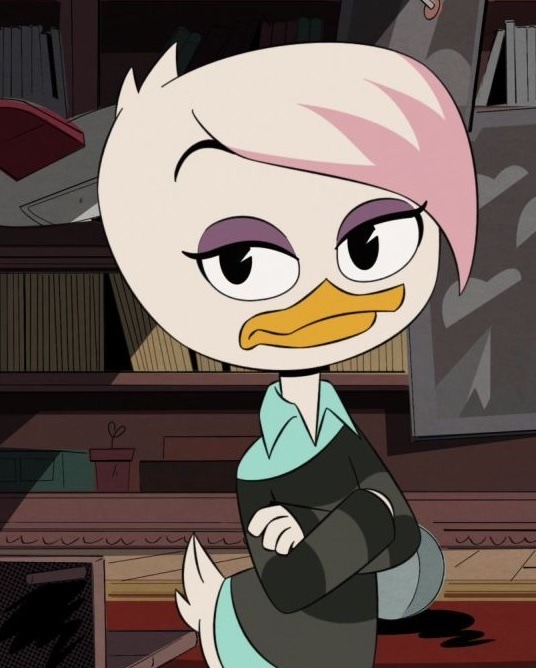


Both Gandra Dee and Jane strike me as the type of bird if someone like Lena or Gosalyn sassed back or was “disrespectful” to them they wouldn’t be angry in the slightest
They’d be like “Nah. This chick is going places. Keep up the disobedience. Also it’s cool if you swear in front of me, I ain’t a snitch”
#also they’re all on a first name basis. none of that ‘miss’ or ‘ma’am’ crap#ducktales headcanons#ducktales 2017#ducktales#gandra dee#jane ducktales#ducktales jane#lena sabrewing#lena de spell#ducktales lena#gosalyn waddlemeyer#gosalyn mallard
72 notes
·
View notes
Text
Me: internet Safety is important!!! Don’t share personal infoemation about yourself especially minors !!!!!
Also me: liveblogs my day
#I’m currently sat in my school parking lot cross stitching#cause I’m not gonna leave my sister to ride the bus on the first day#I’ve defintely got a very protective mother duck attitude going on#i actually have no idea if mother ducks care about their babies#but the make way for ducklings mom did#what’s her name#mrs mallard duh#text post#chitter chatter#kestrel calls
3 notes
·
View notes
Text
A bird with a good name is the least grebe. If that grebe grebe'd any less there wouldn't be any grebe there, hence it is the least grebe possible without no grebe.

[a least grebe shown next to mallard duck]
image credit: Richard Ditch -> https://richditch.wordpress.com/2013/01/22/maricopa-countys-first-least-grebe/
2K notes
·
View notes
Text

Name: Bowling Pin
Debut: Bowling
Yeah, Bowling! It's the pin, from Bowling! Bowling is a game, so it is fair game for this blog. And the pins are Weird Enemies! The whole point of Bowling is to Defeat as many pins as possible. You are taught to HATE them! It's messed up. I will teach you to love them.

When anthropomorphizing a bowling pin, are you on Team Face On Tip or Team Face On Base? I think both have their merits. Tip is good for if you want to give it a humanoid impression, like it could walk up to you and shake your hand. Hug you. Even... kiss you?! Base, however, is more of a creature, which I imagine waddling around on a bunch of legs or tentacles emerging from the bottom. It would hobble up to you and ask you, "Gleep gwanorb?" Answer carefully, or it might aim its Space Ray Gun at you! In the base design, the tip of the pin could be an antenna, or it could be read as a long-haired creature that tied its hair up in a tall bun!

You know something messed up? There are more types of bowling pins! No one ever told me that! The classic one we all default to is the Ten-pin, but there are two others! We'll get to them. Biologically, a Ten-pin must abide to the specific standards set by the United States Bowling Congress, adopted by World Bowling. They MUST be 15 inches (380 mm) tall, 4.75 inches (121 mm) wide at their widest point, and weigh 3 pounds and 8 ounces (1.6 kg), give or take 2 ounces (.057 kg). Wow! These would be some unrealistic standards to live up to, if these were not chunks of carved and coated wood produced specifically to match up to these measurements.
The reason the different pins are pictured with different balls is that they are used in different variations of the game! Candlepin is pretty self-explanatory. It's shaped like a candle. But Duckpin? That looks like a smaller, cuter, more marketable Ten-pin. What's its deal?
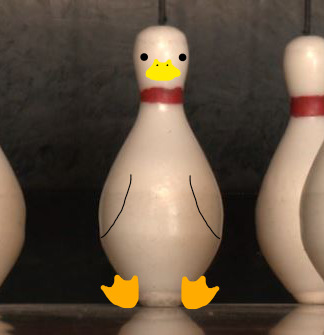
My first thought was, it's called a Duckpin because it looks like a duck! It has the one red line like the ring around a male mallard's neck, and it is rather shaped like a duck as seen from the front, overall! How cute! In reality, they are called Duckpins because the way they scatter when hit reminded a duck hunter of a scattering duck flock. Always comes back to violence with poor little Bowling Pin. They have it so rough! They could really use a friend, who's always there to pick them up when they're down.

Name: Pinsetter
Debut: Bowling
Pinsetter is just the sort of friend a Bowling Pin needs! No matter how many times Pin is knocked down, Pinsetter will be there to pick it up and put it back in its deserving spot. If any mean ol' stray Bowling Balls try to land a cheap hit, Pinsetter's sweep bar will block them. Play fair, you bully ball! Pinsetter's job used to be done by human Pin Boys, but there can still be a human in the mix, making sure the machine is clean, and unjamming it if need be. I can only assume this beautiful relationship between human and machine is just like that of horse and rider.
The more I think about it, though, is Pinsetter really helping? It's just putting the pins back in harm's way every single time, facilitating their unending torment. It blocks incoming balls, but only briefly, allowing them to crash through the pins as soon as they're all reset. Why does it do this? Who does it work for? Who is sending all these balls?!
...It's Pinsetter.
Pinsetter does not only set the pins. It detects the score, encouraging players to hit as many pins as possible. It returns the balls, giving them the weapons to do so. Humans think they're playing a game, but Pinsetter is playing them all! It controls the whole operation, driven by nothing but pin bloodlust! Maybe Bowling Ball has been misunderstood, another tortured soul, an unwilling pawn in Pinsetter's twisted game!
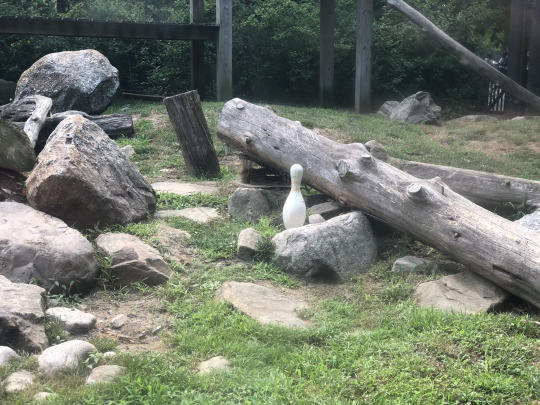
Bowling Pins are beautiful creatures. They belong in the wild, or with trustworthy, knowledgeable caretakers. To bowlers, they are an Enemy. To me, they are a Friend.
#bowling pin#bowling ball#duckpin#pinsetter#bowling#bowling enemies#bowling allies#bowling friends#not mario#funky friday#mod chikako#long post
420 notes
·
View notes
Text
I would be an excellent prime defenders character because i would bully Mallard Conway soooo easily. First of all i would tell him that his fit makes him look like some sort of evil Yo Gabba Gabba character or maybe the carpeting of a motel. then I'd tell him how he has a dork fucking name then say how it does it feel to be named after a type of duck, you british dork? i bet your parents sent you to boarding school as a kid because they didn't want you around. bitch.
#btw none of this is criticism of bizly's writing or anything from a writing perspective hes a very cool villian#jrwi prime defenders#i speak#mallard conway#prime defenders#just roll with it#jrwi pd#jrwi
70 notes
·
View notes
Text
Just a random post
let me ramble about my au (╥﹏╥)
I just think it's funny
Yes most of my ttte au humanization had some redesigns and their characteristics/personality either improved or not
But none of them had been improved and redesigned unlike this fucker ....
Spencer, it's Spencer..... And he barely stays in my story for that long ༎ຶ‿༎ຶ
Like every time I draw him his design is just all over in my au and his personality too. I had sketches and sketches and notes of what he should look like and how he would act
I mean look-
The first time I drew him and originally he was supposed to be the worst of the worst in my corrupted au originally he was supposed to be one of the bad guys in my au that helped Jackie aka Corrupted Leader ..... But then that plot was scrapped

Then he was redesigned and changed his personality again, yes he was more of a jerk but he wasn't as horrible as before but he was more of a calmer but more afraid of things, he actually cared about some people -
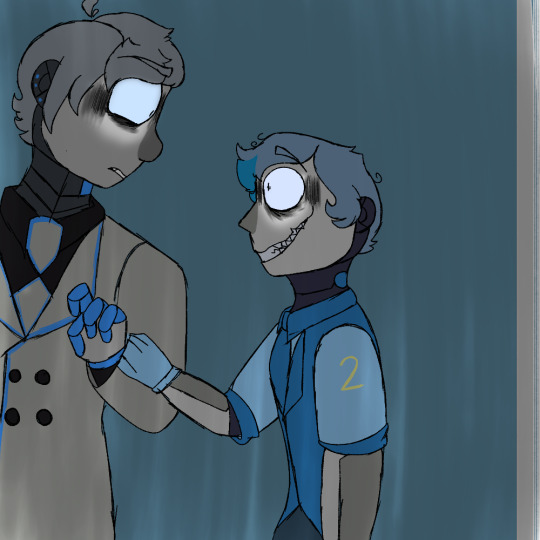
Then I rewrite his personality again -
Later, he's calmer than before and very nice, but very tired retired chief in the UK Air Forces, he cares about his family and everyone just has a little bit of an attitude
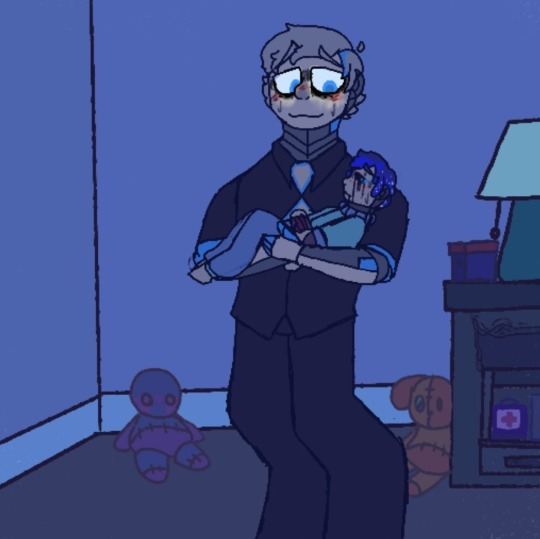
Now later on he becomes more sad and tired, heck very angry even but he puts his anger on Mallard (which he's very much a joke and jerk in my au)
He's very depressed because when the corrupt attack him and ripped him in half
Spencer thought that made him "useless" he thought to himself and "useless to the family name"

And now look at him
Yes he had a lot of recovery due to his injuries, he's a lot more tired but happier and kind thanks to his other family members helping him out

And now he also has a little friend :]
Ok random ranting done :]
#ttte#thomas the tank engine#ttte corrupted au#ttte humanoid#ttte humanized#ttte spencer#spencer the silver engine#Spencer the engine#Thomas and friends Spencer#Thomas the tank engine Spencer#thomas the tank engines#drawing improvement#character development#just a random post#random
28 notes
·
View notes
Text
Hey phandom!!
Do you love Danny phantom but wish there was more canon angst? More development on the fact that he's literally fucking dead? An ongoing plot rather than an episodic show? Wish the show was made by... decent people rather than bitch hartman?? Then boy do I have the suggestion for you!
Introducing:

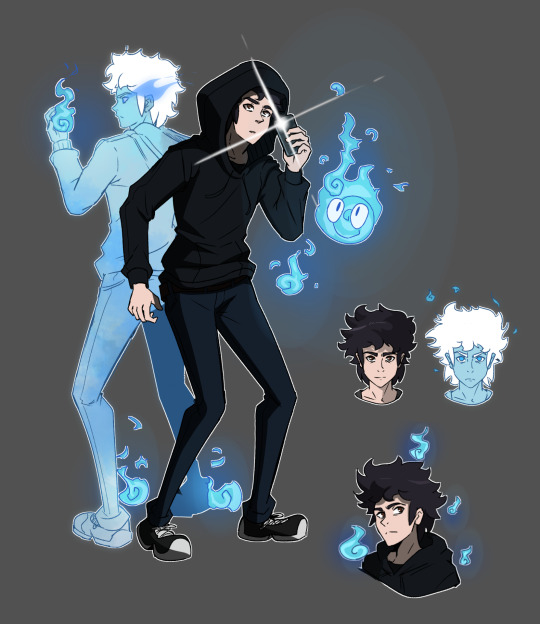
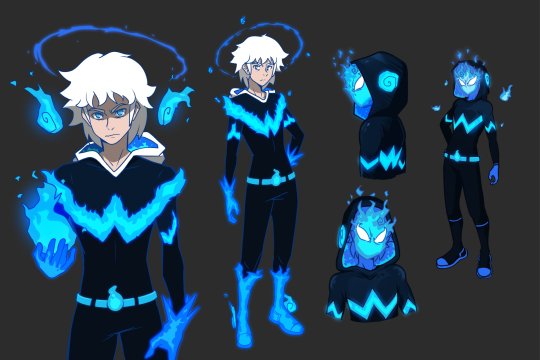
William Wisp is one of the main characters for the dnd podcast, Just Roll With It for their superhero campaign Prime Defenders! He is a character explicitly based on danny phantom, and man does it include so much of the potential angst of dp! And honestly? He's like dp but with more social anxiety. His player, slimecicle, is a GOD at coming up with puns and one-liners on the fly so he fits perfectly.
William is a mystery investigating teen who fell off a cliff and died, but miraculously survived with the help of little blue ghosts called will o' wisps, which also give him ghost powers (including the classic walk through walls, disappear and fly of dp). Because of these powers, he was invited to join the Prime Defenders, a team of teenage superheros being trained to protect Prime (the planet they're on), and he's now a superhero called The Whisperer!
Need some more convincing? Here's an actual intro for one of the episodes in s2 (minor s2 spoilers):
youtube
And here's a (fan-made, but by one of their official artists) introduction to all of the characters (William's bit starts at 1:11):
youtube
I have some more stuff to convince you, but this is getting into spoilers so first I'll tell you where you can find prime defenders!
Now, unfortunately prime defenders is their patreon campaign, so is available for $5 a month on the Just Roll With It patreon, but the first 5 episodes (as well as the 2 prequel episodes, which give some good background but aren't really that important) are available for free! Here is the link to episode one, and if people want more info about the prequel episodes, feel free to come and ask me! They just finished season 2, and they definitely have plans for a next season (after a hiatus for the GM to get stuff together)
youtube
Now. Onto spoilers!
[PT: Now. Onto spoilers!]
So this is mostly going to be a list of William lore/stuff that happened that i enjoy as a danny phantom fan!
So William grapples a LOT with walking the line between alive and dead, one of the major parts of his lore is the fact that he keeps running from the fact that he's dead! He has a ghost form like Danny Phantom does, but William's ghost form is like. a seperate entity to himself. as in his ghost leaves his body and leaves his corpse behind. william has said that every time he does it, it feels like dying.
Also, he's canonically decomposing. and also doesn't have blood or a pulse. or need to breath. or sleep. in canon. Also he keep dying. As in his spirit keeps leaving his body. He's now died 4 times as of the s2 finale, and I think he can technically die as much as he wants now? I'm not sure his last death was literally in the finale so they haven't had much time to develop on it.
If you want a taste of William grappling with,, being dead, here's a clip from the end of one of the episodes that they got animated! It also gives a good idea of the GMing style and the acting/voice acting for William, as well as some of Will's other lore!
youtube
Do you like vivisection? Perfect! There is vivisection in Prime Defenders! It's not actually happening to William, but it is a pretty big part of his lore, and he is like. complicit in it! and if you like cryptid phantom, you'll love this arc as well! Here's some of the official art from that arc just to prove it:
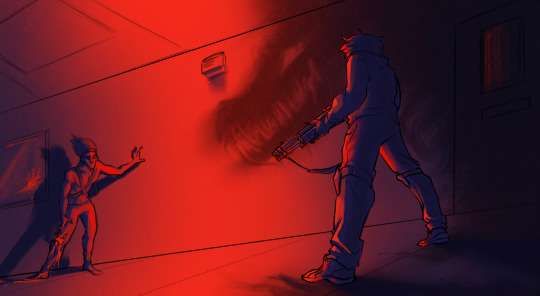
Do you like Vlad? That's great! There's a Vlad type character for William as well! His name is Mallard Conway and he is equally a creep that we don't like <3
Do you like ghost king Danny? That's great as well! William isn't quite the ghost king, but he is the Whisperer, which is a similar position of power! I can't remember the exact details, but basically he's really important to preventing their version of the ghost zone from being destroyed, and so is generally a very important ghost!
Now this bit is like. end of the s2 finale spoilers and let me tell you, if you're already convinced, STOP READING RIGHT NOW, and if you aren't quite convinced GO WATCH THOSE CLIPS I ATTACHED OR GO WATCH OTHER CLIPS FROM THE SHOW, I am happy to send people some if they come ask me, but I swear the experience of this scene is so much better if you AREN'T spoiled for this so STOP READING AND GO LISTEN TO IT RIGHT NOW. ok now it should only be people who REALLY aren't convinced/really don't care about spoilers, but I mentioned that William is the Whisperer? well he's actually the successor of a previous Whisperer, who is canonically voiced by david kaufman, aka the voice actor for danny phantom. yes, for real. aka. william wisp is BOTH IN AN OUT OF CANON the succesor of danny phantom.
anddd that's about all I can think of right now, but I promise you Prime Defenders is a lot of fun so go! listen to it! and also as much as I love William, if you do end up listening to Prime Defenders, make sure to give the other characters some love as well!! Have fun!
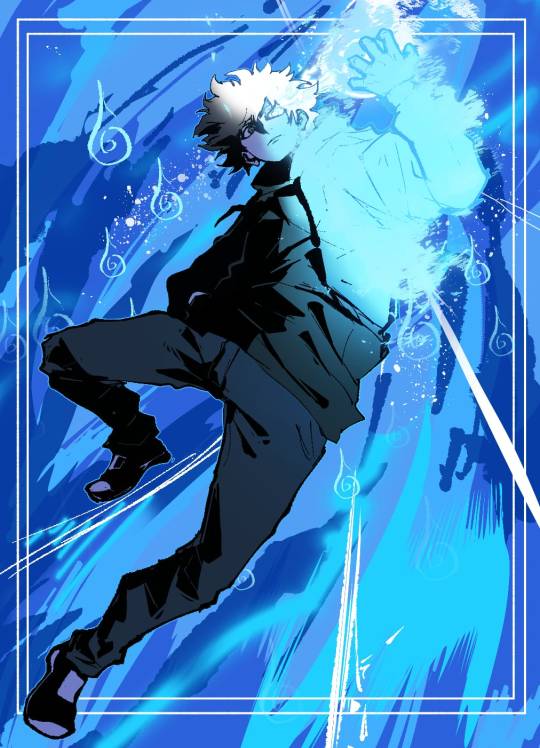
#danny phantom#dp#i dont actually know what tags are used for dp that much i mostly just use the danny phantom tag ahah#prime defenders#jrwi prime defenders#just roll with it#william wisp#so that jrwiblr can see this if they want to teehee#anyway also prime defenders has been going for over 2 years now and NO ONE has made a danny phantom prime defenders au/crossover yet!!!#i am shocked and also potentially in the process of writing a pd x dp fic#(even the initials are the opposite!!!!! its like the were made for each other!!!!!!)
47 notes
·
View notes
Text
Hello Prime Defenders enjoyers!
I am Anti and I own the coolest prime defenders discord on this planet!
https://discord.gg/kBPNEqmaf4

We have everything
Artists!
Cosplayers!
Writers!
Cool people in general!
We are a wonderful group of individuals who want you to become one of us!
Is this a professional server? No!
This is a low stakes, mostly chill, totally rad, mildly cursed server!
We mainly cater to prime defenders, but we have channels for Riptide, blood in the bayou, apotheosis, and basically will have space to chat about any jrwi campaign!
We have all you could ever want in a server!
Carl bot can let you make your name whatever color you want! And let you add pronoun roles to ur profile! All without having to ask about it!
If you are a system, we have plural kit for your convenience!
First server? No problem!
Our mods are literally just regular people who use the server to goof around in just as much as the next person! Ask em anything any time ever.
We look forward to meeting you!
(warning, half the server will say hi to you upon joining, I am sorry if we scare you we are just excited)
Mallard Frogway, the server image by @ollylotl
#jrwi#just roll with it#prime defenders#jrwi pd#jrwi prime defenders#jrwi show#this man ate my son and my lesbian wife </3
53 notes
·
View notes
Text

Raven was submitted without propaganda.
Donald:
Twice the birds named! He's nicknamed Ducky because his last name is mallard (so, duck) AND because his first name is donald (like donald duck)
20 notes
·
View notes
Text
Happy Mallard Day!
Most people in my country will be celebrating tomorrow, July 4th. I’m a bit unusual for an American in that I’m always more excited for July 3rd, because a remarkable feat of engineering history happened that day in 1938 (in multiple senses of the word). Today I’m going to tell the story of a locomotive named for a duck.
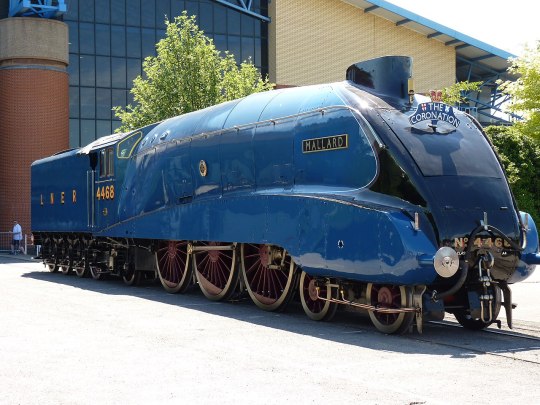
(Image: 4468 Mallard, a streamlined 4-6-2 Pacific locomotive, sitting pretty in York, England, United Kingdom. She is painted bright blue with red wheel spokes.)
The story begins well before July 3rd, 1938, of course - mechanical engineer Sir Nigel Gresley was well established in his position as the CME of the London and North Eastern Railway by that date. In 1923, his most famous creation, a 4-6-2 Pacific A1 numbered 4472, took to the rails for the first time. Originally numbered 1472, within a year of running between London to Edinburgh she received her more familiar 4472 after the LNER finally settled on a company-wide numbering scheme - and the name she’d be best known under, Flying Scotsman. She became the company’s flagship locomotive and solidified Gresley’s ability to design Pacifics in the mind of the public.
Her most important contribution to what I’m about to get into the meat of here, though, occurred on November 30th, 1934. On that date, pulling a light testing train behind her, Flying Scotsman hit 100 mph, becoming the first locomotive to hit that speed whilst being officially measured. Other locomotives may have reached 100 mph before, most notably GWR 3700 City of Truro and NYC 999, but this was the first time the speed was officially recorded, and so Scotsman got her name into the record books.
Dating back to the 19th century, railroads in Great Britain competed against each other in what was known as the Race to the North, in which they actively attempted to outdo each other and get passengers from the south, usually London, up to various destinations in Scotland. Nobody ever actually said they were racing, of course, but in retrospect it was pretty obvious what was going on as the railroads introduced faster and faster services. By the 1930s, the railroads had been consolidated into four companies - the Big Four (the Great Western, the Southern, the London, Midland and Scottish, and the heroes of this story, the London and North Eastern). The LMS controlled the West Coast Main Line, and the LNER controlled the East Coast Main Line. (This is important.) In 1927, the LNER started running the named train Flying Scotsman non-stop from London to Edinburgh, utilizing corridor tenders to perform crew changes at speed without stopping. Not to be outdone, the LMS beat them to the punch, running non-stop services between London and Glasgow and London and Edinburgh on their own, and it was officially on. Although speeds were still within a reasonable range at this point, both railroads knew they needed to go faster, and Sir Nigel Gresley looked to Germany.
In Germany, a new streamlined service called the Flying Hamburger had been introduced. This was a diesel train set that ran between Hamburg and Berlin at remarkably high speeds - it had an average speed of 77 mph and could hit around 99-100 mph at its maximum. For regular service, this was impressive, and Gresley wondered if the same could be done using steam power. He knew streamlining was the key, but the LNER knew that the diesels in Germany didn’t have the same passenger capacity as their steam locomotives could pull in carriages, so he needed to get creative. He looked to Bugatti for inspiration; their racecars, in their resplendent blue, were but one thing the car company was working on - they were making streamlined railcars, as well. Gresley took note of their designs, and his new locomotives would eventually pay homage by being colored Bugatti blue.
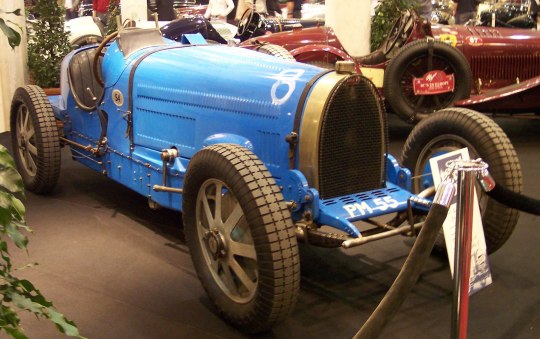
(Image: a Bugatti Type 54 racecar, painted in a vivid blue.)
By the time Flying Scotsman hit 100 mph in 1934 and another Gresley Pacific locomotive, A3 2750 Papyrus, managed to hit a whopping 108 mph without streamlining, the LNER knew that Gresley was capable of the task, and they allowed him to design a streamlined locomotive. Gresley set to work making improvements to his A3 design, and the first four A4s were born.

(Image: an unidentified A4 Pacific locomotive.)
The A4s were fast, hitting 112 mph on the inaugural run of the Silver Jubilee service between London and Newcastle in 1935. Gresley, of course, was not satisfied - he knew he could still improve his design, and at any rate, his competition over at the LMS was going to be trying to catch him. He went back to the drawing board to make the A4s even better.
As this was going on, the LMS was indeed playing catchup, and they introduced their beautiful Coronation class locomotives, designed to pull the Coronation Scot starting in 1937. The first several of them were streamlined in gorgeous, bright casings, and they caused a stir, taking the British speed record back at 114 mph in an attempt by 6220 Coronation that ended with a sudden braking and a whole lot of kitchenware being flung every which way in the dining car. Engineer/driver T.J. Clark and fireman C. Lewis kept her under control, but the passengers were not amused, and speed records were shelved for the time being...until, once again, Germany entered the fray.
Back in 1936, a German locomotive, the DRG Class 05, set a land speed record for steam, hitting 124.5 mph. Gresley was aware of this and had it in the back of his mind as he improved his A4s. He experimented with giving some of them a Kylchap exhaust system, an innovation developed by French locomotive designer André Chapelon after the work of Finnish engineer Kyösti Kylälä. Chapelon’s work went woefully under-acknowledged, but Gresley paid attention and appreciated his work, and it would pay off. Wind tunnel tests proved a bit frustrating at first until a fortuitous accidental thumbprint helped to move the smoke up and over the locomotive instead of in the crew’s faces, and the stage was set.
4468 Mallard rolled off the line at Doncaster Works on March 3rd, 1938, her name derived from Gresley’s love of breeding waterfowl. Indeed, many of her sibling locomotives were also named for birds, like 4464 Bittern, 4467 Wild Swan, 4902 Seagull, and 4903 Peregrine, but the duck was about to steal the show. Mallard spent the next few months getting used to working and being broken in so she wasn’t brand new, and on the day she turned four months old, it was time to make history.
Mallard’s driver that day was a 61-year-old grandfather named Joe Duddington. As a locomotive engineer, he was experienced and knew how to take calculated risks, and so he’d been assigned to pilot her. With him on the footplate was fireman Tommy Bray and his massive tattooed arms, ready to keep Mallard fed as they drove into the history books. They were performing a “brake test” that day, or so the LNER told most people, passengers included, but Joe and Tommy knew what was actually going on. In the cab with them was an LNER official, Inspector Jenkins, and attached to the train behind the tender was a dynamometer car, there to record Mallard’s speed throughout her run. Since this was an alleged “brake test” the dynamometer car didn’t raise any eyebrows right away. Gresley himself unfortunately wasn’t in the best health that day and was unable to be present himself, but there were enough LNER officials on hand to see to it that everything ran smoothly. Mallard was fitted with a stink bomb of sorts of aniseed in case the big end bearing for the middle of her three cylinders overheated, as the A4s had previously had difficulty with this, and she set out heading northwards. The return trip was where everything was going to get serious.
Upon turning around to return south to King’s Cross, passengers were finally informed of what was going to happen and were given the opportunity to disembark and take another train if they were worried, especially given what had happened during the LMS record attempt a year prior. Everyone agreed to stay on board. Joe Duddington turned his hat backwards, a reference to George Formby’s character in the film No Limit, and opened the throttle.
Mallard slid back onto the main line, headed towards Grantham, where the speed-up was to begin. Unfortunately, work on the track limited her to only 15 mph at this stage, and Joe Duddington got her through the Grantham station at only 24 mph instead of the 60-70 mph she should have been at. Nevertheless, she began to build up more and more speed as she climbed up Stoke Bank, and Duddington had her at a solid 85 mph at the summit.
“Once over the top, I gave Mallard her head, and she just jumped to it like a live thing,” Duddington recounted later in an interview. Her speed rapidly increased, and she was soon hitting 110 mph, at which point he told her, “Go on, old girl, we can do better than this!” Mallard responded, and by the time she was flying through a village called Little Bytham, a blur of blue paint and pumping rods and flying ash, she had well exceeded the LMS record and was even with the German DRG Class 05. The needle in the dynamometer car tipped up higher and higher and surpassed the Class 05 by slipping up to 125 mph...then, for about a quarter of a mile, reached even higher, at 126 mph. She’d done it.
Mallard had to slow down soon after because of a junction, but Joe Duddington and Tommy Bray were sure she could have gone faster had they not had to slow for construction - they believed she was capable of 130. The big end bearing did overheat, and Mallard was detached from the train at Peterborough and brought back to Doncaster to be fixed up, but not before one of the most famous photos in railroad history was taken:
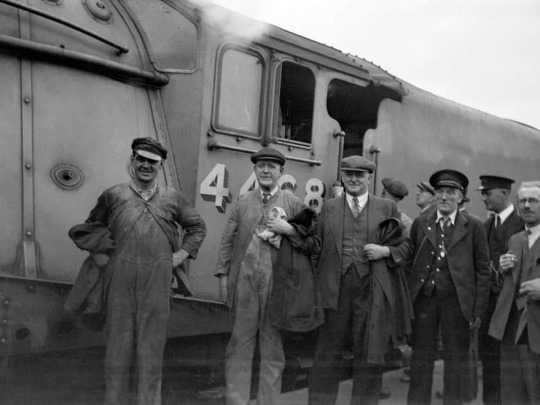
(Image: the crew poses in front of Mallard, a 4-6-2 Pacific locomotive numbered 4468, immediately after setting the speed record. L-R: Tommy Bray [fireman], Joe Duddington [driver/engineer], Inspector Jenkins, Henry Croucher [guard/conductor]. Joe Duddington has turned his hat around to face the correct way again after having it on backwards during the record run. Photo credit: National Railway Museum.)
Joe Duddington actually stayed on a bit past his retirement age to help free up soldiers for the war effort. When he finally retired, on his final day of work, he drove Mallard one last time.
Sir Nigel Gresley himself never accepted the brief stint at 126 mph, instead saying his locomotive set the speed record at 125 mph. But history has accepted the 126 mph as the true top speed, given that Mallard was possibly capable of even more, and today she has plaques on her streamlined cladding to commemorate her feat. A second record attempt was planned to see if she could go even faster, but World War II broke out and the idea was scrapped.
undefined
youtube
Tommy Bray eventually got on the throttle himself, fulfilling his own dreams. Both men are honored in a cemetery in Doncaster with a new memorial headstone for Duddington featuring Mallard on it.
As for Mallard herself, she continued working until April 25th, 1963, at which point she’d clocked nearly a million and a half miles in service. She was pulled for preservation for obvious reasons, and today she lives at the National Railway Museum in York, along with her dynamometer car that recorded her history-setting run. Five of her A4 siblings also survive, and a few of them are operational to this day, including the one named for her designer, Sir Nigel Gresley. Of all of his ‘birds,’ the one that flew fastest was the humble duck.
For more on Mallard and her creator Gresley, here are a few resources:
Mallard: How the Blue Streak Broke the World Speed Record by Don Hale is a great book on the subject that I enjoyed thoroughly. It does have a Kindle edition if you’d prefer an ebook variation, as well, and most major book retailers carry it on their websites.
The National Railway Museum, Mallard’s retirement home, has a 3D experience/ride of sorts that simulates what it was like to be running with her that day, the video of which is online here. Note the music, which mirrors her three cylinders pumping away. The video isn’t able to be embedded, but you can watch it here. There’s also a child-friendly version, too.
Lastly, the appropriately named prog rock band Big Big Train did a song about Mallard called East Coast Racer, which regularly moves me to tears because this locomotive means so much to me and they tell her story so lovingly.
undefined
youtube
I actually recommend checking out the live version, too, because they show the photo of the crew at the end and every single time I start sobbing.
If you want to visit the old girl herself, she’s at the National Railway Museum in York in the UK, and they have a ton of amazing resources and incredible locomotives and rolling stock in their collection. I’d highly recommend checking them out if you can!
Happy Mallard Day, everyone. Fly far, fly fast, make history.
#LNER Mallard#LNER 4468 Mallard#LNER#LNER A4#I like trains#I spent literal hours on this whoops#but she's really important to me
50 notes
·
View notes
Text
1957 was a big year for David McCallum, the respected Glasgow-born actor known for “The Man From U.N.C.L.E.,” “The Great Escape” and his 20-year run on “NCIS” as quirky pathologist Dr. Donald “Ducky” Mallard.

From the Oct. 23, 1957, edition of weekly Variety
The actor, who died Sept. 25 at the age of 90, logged six mentions in Variety that year, starting with the March 20 edition of weekly that featured him in the cast list of a review of the British “crimer meller” (aka crime melodrama) “The Secret Place.” From then on, McCallum was a staple in our pages, limning movies, TV shows, legit stages in the U.S. and U.K. He never stopped working.

Wedding announcement for David McCallum and Jill Ireland from the May 22, 1957, edition of weekly Variety
1957 was also the year McCallum married actor Jill Ireland in London, an event commemorated with a wedding announcement in the May 22, 1957, edition of weekly.
Five months later, McCallum got his first detailed mention in a review of British drama “Robbery Under Arms,” a Rank film production also starring Peter Finch, Ronald Lewis and Ireland. McCallum was one half of a pair of brothers who get swept into a life of crime, and he was singled out in our review. “Good opportunities are given to the brothers, Lewis and McCallum. The latter, in the more subtle part, enhances his rising reputation.”
Growing up in that era of Britain, it’s no surprise that McCallum was a Rank regular. But by the early 1960s, McCallum’s star climbed as he landed a supporting role in the 1963 Steve McQueen hit “The Great Escape.” (Scandal ensued, however, when Ireland and “Great Escape” co-star Charles Bronson began an affair on the set. Bronson and Ireland were married from 1968 until her death from breast cancer in 1990.)

Congrats ad saluting 1966 Golden Globe Award winners from the Feb. 14, 1966, edition of Daily Variety
Soon after “The Great Escape,” McCallum relocated to swinging Hollywood, co-starring with Robert Vaughn in the spy-fi comedy series “The Man From U.N.C.L.E.” for four seasons. MGM Television produced the NBC series that was inspired by the success of the James Bond film franchise. McCallum earned back-to-back Emmy nominations in 1965 and 1966 for the show, and the series nabbed the Golden Globe Award in 1966 for Most Popular TV Show.
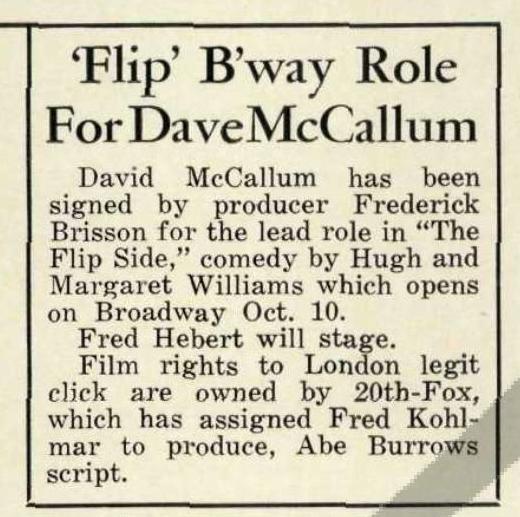
From the June 24, 1968, edition of Daily Variety
MGM kept McCallum busy in features during his “Man From U.N.C.L.E” hiatus. In 1967 he starred in the globe-trotting movie comedy “Three Bites of the Apple” with Harvey Korman, Sylvia Koscina and Tammy Grimes. “Box office is the name of the game … so let yourself go with McCallum,” MGM exhorted in an ad in the Feb. 8, 1967, edition of weekly Variety for “Three Bites.”
Still, he never strayed too far from the boards. “Dave McCallum” landed prime page-one placement in the June 24, 1968, edition of Daily Variety when he was set to star in the Broadway adaptation of the hit London tuner “The Flip Side,” which opened Oct. 10 on the Main Stem and closed Oct. 12.
McCallum juggled all manner of film, TV and stage projects in the 1970s and ’80s. In the early 1970s he co-starred with Robert Wagner in the British drama series “Colditz” — a bit of foreshadowing of things to come decades later when Wagner joined the cast of “NCIS.”
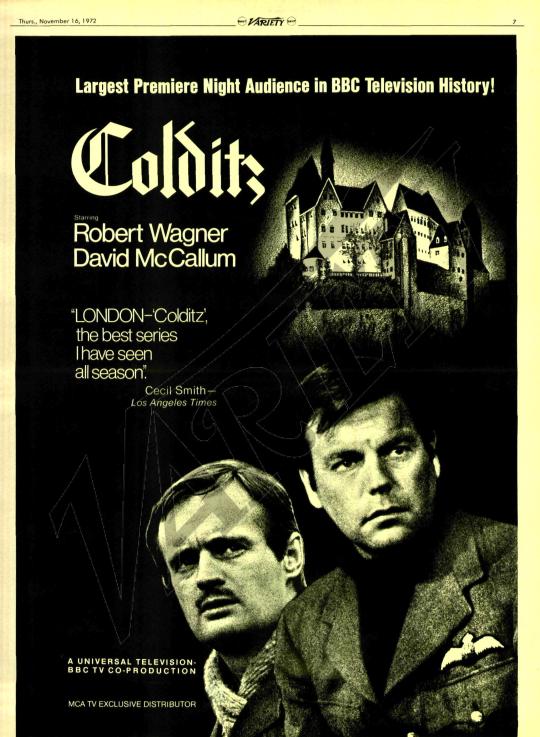
From the Nov. 16, 1972, edition of Daily Variety
And who says reboots and remakes are a recent phenomenon? Fifteen years after the original series ended, CBS reunited Vaughn and McCallum for a “The Return of the Man From U.N.C.L.E.” TV movie that had its charms, according to our review from the April 7, 1983, edition of Daily Variety: “Robert Vaughn and David McCallum resume their spy-snooping as slickly as though they never left,” our critic wrote.
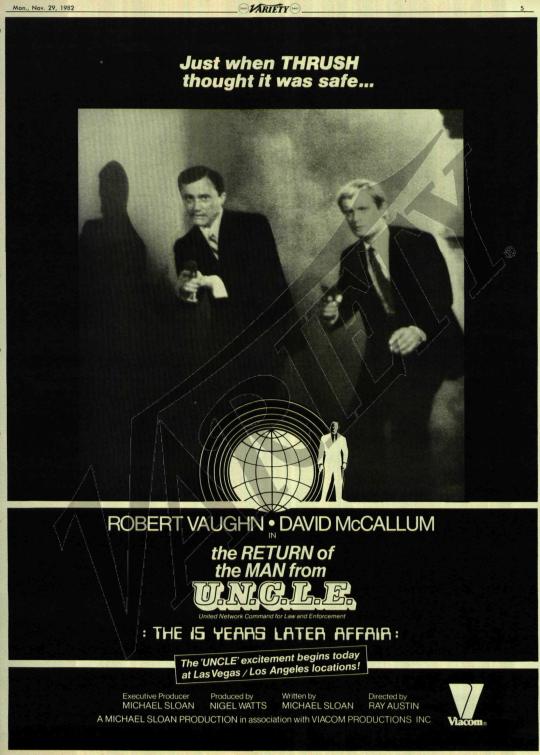
From the Nov. 29, 1982, edition of Daily Variety
Any actor fortunate enough to have a long career will inevitably deal with some downturns. McCallum did a fair amount of low-profile indie and Euro-financed movies in the 1990s. After he landed the “NCIS” gig in 2003, he mostly stuck to moonlighting with voice work in animated series and video games.
In 2012, Variety paid tribute to “NCIS” as it reached its 200 episode milestone – a rare achievement for series and one that has become even more unusual in contemporary times.
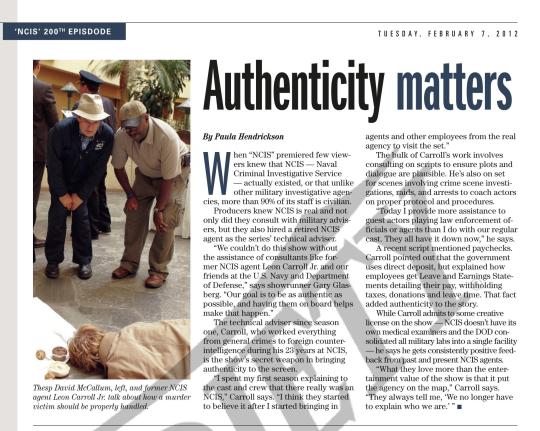
From the Feb. 7, 2012, edition of Daily Variety
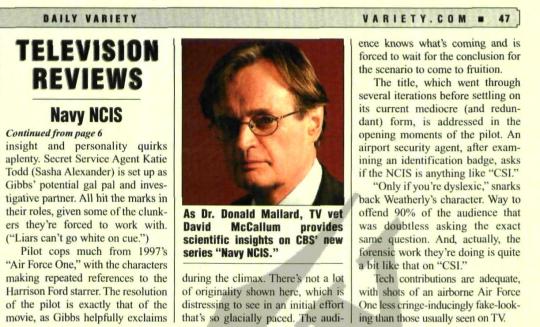
From the Sept. 22, 2003, edition of Daily Variety
We couldn’t have known it back then, but “NCIS” and McCallum were destined to deliver more than 250 more episodes (not to mention two more spinoffs) during his stint on the show, which is heading into Season 21, although the premiere date is still in flux after production was delayed by the WGA and SAG-AFTRA strikes).
The show clearly won’t be the same without his authoritative and avuncular presence. As we wrote in our Sept. 22, 2003, review of the pilot for the series originally titled “Navy NCIS,” McCallum’s character was key to adding “scientific insight and personality quicks aplenty” to the ensembler.
Rest in peace, Ducky.
23 notes
·
View notes
Text
The Fallen King
The Flying Scotsman rolls into the station at the end of a busy day.
Scott: Ahhh. Another successful non-stop run. The A3s will run this railway for years to come.
His driver, William winces.
William: I wouldn't say that, Scott. I've heard some rumors that Sir Nigel Gresley is set to put his latest design, the A4 into service next month.
Scott uncharacteristically splutters and turns red with annoyance.
Scott: This is preposterous! Have I not proven my worth to Sir Nigel Gresley? I can't just be replaced as if I haven't been operating this incredible service to the railway for over 10 years.
William: Shhh. Steady old boy. Just because the design is meant to provide high speed passenger rides, doesn't mean you will be replaced.
Scott: I sure hope so, William.
Time Skip
One day in 1938, Sir Nigel Gresley appeared at the sheds.
Nigel: Good morning, Scotsman.
Scott: Good morning, Sir.
Nigel: I know you've been feeling down about being replaced, but I bring good news. You are being seen as a role model by the A4s. In fact, I want you to take me to the Doncaster Works. There's an engine I want you to meet.
Scott sighs. He knows he shouldn't be so jealous, but he thought he would have his record at least a little longer.
Scott: Yes sir.
The Flying Scotsman takes Sir Nigel Gresley to the Doncaster Works. An engine freshly painted painted garter blue sits on the rails faceless.
Nigel: Now in just a minute, my latest modification of the A4 will wake up. I believe if this works, this engine will once again be a credit to the railway. In fact, as you have been the only engine in recent British history to do so, I want you to mentor this engine. Streamlining by design will make an engine fast, but it takes great skill to manage such high speeds.
Scott: Oh. Well it's an honor, sir.
Scott means what he says, but it's still bittersweet. To him it hurts to have to be responsible for training his own replacement. Being demoted from the Flying Scotsman services was quite a blow.
?: Hello?
Nigel: Ah yes. Welcome to the world young engine. I am your designer, Sir Nigel Gresley. Due to my fondness of birds, I decided to name you Mallard.
Mallard: Mallard, sir?
Nigel: Indeed. The Mallard is one of the most famous birds in the world. Due to the modification I added starting with your design, I highly believe you will become one of the most famous engines.
Mallard: My goodness. Thank you sir!
Sir Nigel Gresley chuckles. He walks over to the Flying Scotsman.
Nigel: This is one of my most famous engines, the Flying Scotsman, known for being the first official engine to reach 100 mph. He will act as your mentor regarding how to handle high speeds. We value fast, safe, and reliable service on this railway. Is that clear?
Mallard: Oh yes sir! Thank you for giving me a mentor.
Nigel: Well I'll just leave you two alone then. There's a lot of work to be done.
Scott sighs. It's not at all Mallard's fault that he feels this way. Given the circumstances, the least he can do is make Mallard as reliable as himself.
Time Skip
Mallard: Scotsman, why am I being asked to pull a train like this just to test my brake?
Scott: This is meant to simulate pulling a real train. The men added a dynamometer car to measure your speed and other elements of your performance.
Mallard: So it was just like my tests before I pulled my first passenger train.
Scott: Indeed. Only this time, the hope is that you will be fit to break the speed record. Should the bearing on your middle cylinder overheat even with the modifications, it would mean more work is to be done. We don't want you hurting yourself just to break a speed record.
Mallard contemplates this. He doesn't want to let anyone down. Especially if it's because of something he can't control.
Mallard: I understand.
Jospeh: Alright, Mallard. It's time to start our journey.
Mallard: Very well then, driver.
Mallard rolls out into the distance. Something about the day makes Scott only dread his worse fear is about to become a reality.
Time Skip
Crowd: He's done! Mallard broke the speed record!
Scott solemnly closed his eyes. Even though he isn't old by any means, this news made him feel as if he's aged.
Gordon: Why the long face, brother?
Scott: I feel as if my time to shine's ended before it truly ever began.
Gordon: Oh don't tell me that you're jealous of Mallard.
Scott looks at Gordon. He shakes his head knowing jealous isn't at all the correct term.
Scott: This is not at all Mallard's fault. He's simply doing what he's told like any young engine would. It isn't as if I didn't know my speed record would be broken one day.
Gordon: So why are you upset?
Scott: I wish I was able to have that to my name a while longer. To be allowed the chance to live out my prime as the best of the best. I would be willing to accept being replaced should it be well over 50 years of service and I'm no longer reliable. But to be replaced this soon.... I just didn't expect it.
Gordon: At the end of the day this is a business. What's best for the business is to ensure our passengers have fast, safe, and reliable rides. By mentoring Mallard, you are ensuring that guarantee. That is being a really useful engine. Like I said before, get some perspective Scott.
Scott shuts his eyes sighing again. If only there was a way to explain that Gordon is right but he should still be allowed to his feelings.
Scott: I only hope that Mallard doesn't meet the same fate as me. Falling from grace for things that is not at all your fault is something I wouldn't wish on anyone. No one should ever have to worry about facing the cutter's torch.
Gordon: Indeed, Scott. Indeed.
AN: Thank you anon for requesting this. I didn't realize that the real life A4s did in fact replace the Flying Scotsman until I started learning about the history a little bit more.
Tagging: @nelllia, @gordon208, @jayde-jots, @mintydeluxes-blog, and @engineer-gunzelpunk.
8 notes
·
View notes
Text
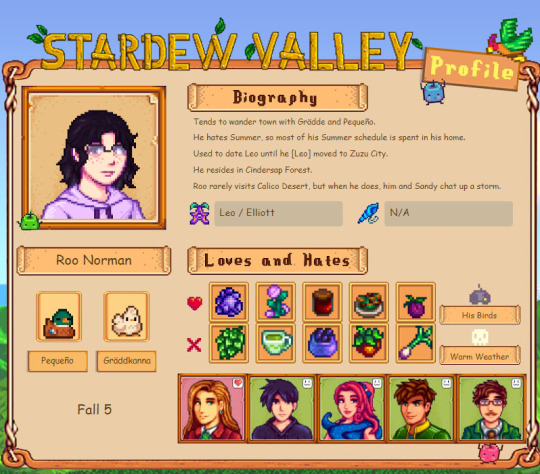
εїз Stardew Valley Profile εїз
ʚ- Roo Norman -ɞ
- -
Made by : @bigeyedkitteh ( Profile maker )
Portraits from : Slightly Edited Portraits by Poltergeister
Duck and Chicken icons from : Elle's Cuter Coop Animals by Elle/Uploaded by junimods
- -

(Just a fair warning, this got a LOTTTT longer than I expected it to 😭)
Because I got a little too invested in this, I'm gonna lengthily elaborate on most parts of the profile, enjoy :)
- -
Pequeño and Gräddkanna/Grädde
Pequeño is a 3 year old Mallard Duck. As a duckling, Pequeño lived with Marnie on her Ranch for a couple of weeks, Marnie was convinced he wouldn't live to see the next week, at this point, as he was scrawny and very obviously a runt compared to the rest of brood. In this same week, Roo was looking for another feathery friend to occupy his space with him and ended up visiting Marnie, and upon seeing the scrawny duckling, he asked Marnie if he could take him in, she warned him, but he was persistent- He left that Ranch with a duckling who could barely hold his own.
It's taken three years of strenuous work to keep Pequeño well, but Roo didn't give up and now, at three years old, Pequeño is alive and, although he struggles from time to time, he is well and very happy. Roo calls him Pequeño because it means little, and Pequeño is a very little duck- Pequeño is also one of the only words Roo knows in Spanish. (Pequeño is also a reference to a tame I had in ARK LMAO)
Gräddkanna, or Grädde, is a 6 year old Cream colored Silkie Chicken. Roo has had Grädde for 4 years, like Pequeño, She was taken in from Marnie, although Grädde was in much better condition than Pequeño upon being adopted. Roo never considered himself to be a bird lover, and especially never considered himself to be a bird owner, but it was like love at first sight when he saw Grädde meandering Marnie's Ranch- So Roo began indirectly asking Marnie if Grädde (or Mila, as Marnie had originally named her) was available to buy, she said that Mila/Grädde was there to stay on her Ranch, but it was the saddened look in his eyes when he was exiting that had Marnie begin to reconsider her choice, and Roo left her place empty-handed. A week later, Marnie showed up at Roo's door, early in the morning with a Silkie chicken being cuddled in her arms, she knocked and was met with a rather grumpy Roo, however he lightened up when he saw Mila in Marnie's arms, She offered him Mila for a low price (15 dollars), while she was willing to give up Mila, she wasn't going to give up Mila for nothing- He happily paid Marnie and took Mila, now Grädde, in his arms.
Grädde co-parented with Roo to raise Pequeño, Grädde was very happy and eager to take Pequeño under her wing (pun intended), and so she did. Grädde and Pequeño are now best friends and sometimes you'll see Pequeño hitching a ride on Grädde's back, this is more commonly seen when Roo is wandering the town and he isn't actively carrying Pequeño, he [Pequeño] does this mainly because he is too weak to walk for long and has to rest, and Grädde is just strong enough to carry around Pequeño for a moderate amount of time.
Gräddkanna means Creamer and Grädde means Cream in Swedish, Roo named/nicknamed her that because of her Cream feathers and because the texture of her feathers reminds Roo of Cream.
- -
Roo Facts 1-5
- ♪ "Tends to wander town with Grädde and Pequeño"
Roo loves his birds, and equally loves wandering as much as he does his birds, so during the day (during any season except Summer), you'll often find Roo wandering about in town or in the forest with Grädde and Pequeño, there's a couple different wandering variations, the most common being him carrying Pequeño with Grädde following suit, an uncommon variant will be of, as mentioned earlier, Pequeño on Grädde's back, and a rarer variant that will only occur later on during your playthrough (around year 2, and progressively becomes more common beyond year 2), is of Roo with only Grädde or Pequeño, this is due to Pequeño's condition and age and Grädde's age, Roo will only carry one of his two birds, as the birds age, Grädde becomes weaker and unable to walk as much and unable to carry Pequeño as long as she used to. As for Pequeño, he is unable to stay out for long at this point, meaning Roo has to leave him at home so he can stay warm, leaving Roo to carry Grädde around town (and vice versa, depending on how Grädde is doing). Another rare variant that only occurs VERY late in the playthrough (around year 4-5+, becomes more common in later years beyond year 6) is of Roo by himself- as mentioned, his birds are old at this point, and around year 4-6, they are too old to be able to even travel with Roo, this variant contains the least amount of dialogue lines from Roo and is the variant where most times, you will not be able to talk to him, due to him being sad about not having his birds (I did not want to include pet death in his story, so Roo's birds do live, however any year after year 6-8 will only include his last wandering variant)
- ♪ "He hates Summer, so most of his summer schedule is spent in his home"
It's as the fact states, Roo hates the Summer and thus doesn't leave his home much for most of the day. You're more likely to see him wander around around sunset, as it's cooler and isn't nighttime where his birds won't get lost. Due to this, it is significantly harder to befriend and/or romance Roo during this season- it's still possible, just a bit frustrating/difficult to do so. To get a brief/broader look at his schedule during the summer, here's a time chart of his weekly summer schedule:
Mon-Thurs, Sat :
[ 9:00 AM: Waking up
[ 10:00 AM: Tending to his birds
[ 12:00 PM - 4:00 PM: Hanging out around his home with his birds, awaiting sunset
[ 4:30 PM - 5:30 PM: Nap
[ 6:00 PM - 8:00 PM: Town wandering with his birds (or without, depending on the year)
Fri :
[ 10:00 AM: Waking up
[ 11:00 AM: Tending to his birds
[ 1:00 PM - 4:00 PM: Cleaning house
[ 4:30 PM - 5:30 PM: Nap
[ 6:00 PM - 8:00 PM: Town wandering with his birds (or without, depending on the year)
Sun :
[ 11:00 AM: Waking up
[ 12:00 PM: Tending to his birds
[ 2:00 PM - 3:00 PM: More house cleaning
[ 3:30 PM - 4:30 PM: Hanging out around his home with his birds, awaiting sunset
[ 5:00 - 5:30 PM: Nap
[ 6:00 PM - 8:00 PM: Town wandering with his birds (or without, depending on the year)
- ♪ "Used to date Leo until he [Leo] moved to Zuzu City"
Leo and Roo briefly dated/were friends with benefits (it was complicated), Leo was new to Pelican Town, and it didn't take long for him and Roo to hit it off, however, Leo did not fancy the small farm/town life, and left a couple of months later for Zuzu city, officially cutting it off with Roo. This took place before Roo got his birds and when he was also new to Pelican Town (albeit, not as new as Leo)
- ♪ "He resides in Cindersap Forest"
Roo technically lives in Cindersap Forest, he lives in the forest gap between Cindersap Forest/Marnie's Ranch and 1 Willow Lane (Sam's house), i'm sure ya'll know what I mean, but here's where he is on the map (for all my visualizer homies out there):
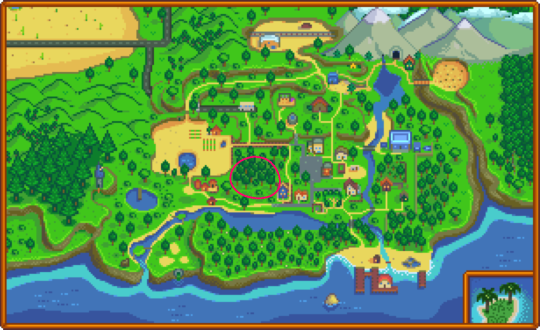
Roo's home is unavailable during the very beginning of a playthrough, and you cannot meet him properly until the Flower Dance. It IS possible to meet him during the Egg Festival, however he is off to the side somewhere beyond the bar, over by Dusty- At this point, Roo won't really talk to you, and will only say "Hello." before going back to watching the festival from afar, this will not count as meeting him. Going back to the Flower Dance, he is found standing awkwardly off to the side by Elliott and Leah, you can talk to him, and he'll, like before, say "Hello." and this will count as meeting him, and you will see him around town from here on out.
After meeting Roo, two new areas will be introduced, when going between Cindersap and Pelican town, you will instead go to a small threeway intersection instead of going directly to and fro- going upwards will take you to another small area which is where Roo's home is. I don't have an exact image of what his home looks like right now, but just know it does have a little fenced off area for his birds, and the inside of his home is pretty duck/chicken-proofed.
Roo's home cannot be entered until you get 2 hearts with him, and after reaching 2 hearts and entering his home, you will have to further your relationship with him (4 hearts) to be able to enter his bedroom.
- ♪ "Roo rarely visits Calico Desert, but when he does, him and Sandy chat up a storm"
Perhaps one of the biggest surprise facts LMAO Him and Sandy are really good friends, unfortunately he doesn't visit a lot cause he hates the warmth of the Desert, but he does occasionally visit her, and their vibes actually compliment each other well and they like to chat and even sometimes gossip between each other (although Roo doesn't like to gossip a lot so it's moreso them just chatting).
- -
Favorite Thing
I just wanted to briefly elaborate on this one, but it's kind of two things (ofc I couldn't put two), Leo is his favorite thing/person, but since Leo has left and since Roo has... mostly... moved on, Roo's new favorite "thing" is Elliott, he's absolutely enamored with him. (It seems Roo's growing type is long hair...)
- -
Favorite Villagers
His absolute favorite villager is Elliott, he could marry Elliott if he could, and while Elliott does like him back, Elliott has established that he doesn't want to take their relationship further.
Following Elliott (in order of most liked to least), is Sebastian, they both share a very familiar emo/grunge-y vibe... Next is Sandy, who I've talked about- Then it's Alex, who's kind of a guilty-like/crush, Roo doesn't really like some of Alex's ideals/outlooks, but he can't help but catch himself admiring Alex's face when he's near- and lastly is Harvey, Roo thinks Harvey is cute and they're good friends, but Roo is a little weirded out by the fact that Harvey's name is... well, Harvey- If you know Roo lore, you'll know that Roo's birthname is Harvey and thus why Roo getting with Harvey would be a little strange.
Saying Roo doesn't like any of the aforementioned villagers isn't right, he loves all his friends (and Elliott a little moreso), however there are a couple of villagers he doesn't like... 👀
- -
Other Random Facts
★ Roo and Elliott, ironically enough, have the same birthday hehe
★ While Roo is romancable, his sexuality is still in place, and is the only villager/character who is only romancable to male villagers/characters/farmers. If a female character tries to romance Roo (Asking him to the flower dance, Bouquet... etc), He will reject them and their advances, you'll lose a heart with him initially and if you try again a second time, you'll lose 2 hearts and if you REALLY just cannot give it up and try again, you'll lose all your hearts with him and all his dialogue with the farmer will change (basically being distant), you can regain hearts with him, but it takes twice as long and if you do end up trying again for a FOURTH TIME, he'll reject you and will become incredibly distant to the farmer, and you will not be able to regain hearts with him.
★ Most of Roo's disliked items are items that can only be acquired during the Summer (Spice berry, Hops, etc), which goes hand in hand with his general dislike for Summer altogether- While most of his liked items are catered towards Fall items (Fairy Rose, Wild Plum, Plum Jam, etc). Even though his likes/dislikes are catered toward preferred seasons, he also has separate reasons for liking/not liking those things (not liking Hops because he doesn't like beer / liking Fairy rose because of the color)
#this took fucking forever btw like literally from 12 am to now. 7 am... just typing away at this and making resources#also recolored the Roo portrait a little bit cuz i didn't like the og colors... </3#anyways... another episode of “Roo getting too invested in Roo's character and writing to their heart's content”#sorry for the absolute yap nation that is the under-the-cut content#i loveeeddddd doing this but i feel so bad for putting so much text 😭😭#if i knew how to make stardew mods (and stardew sprites...) I would ABSOLUTELY make Roo in Stardew Valley ugh..#sort of a fun fact idk- but I was going to add SOOO much more for each category but I decided not to-#-mainly because I didn't have the brain capacity but also to save yall from an even longer post LMFAO#Roo#Varooity : AU!Roo#Varooity#Varooity : SDV#Stardew Valley#sdv#oc#my oc#yapping#queueueueuey
17 notes
·
View notes
Text
Migration + Mooned Review
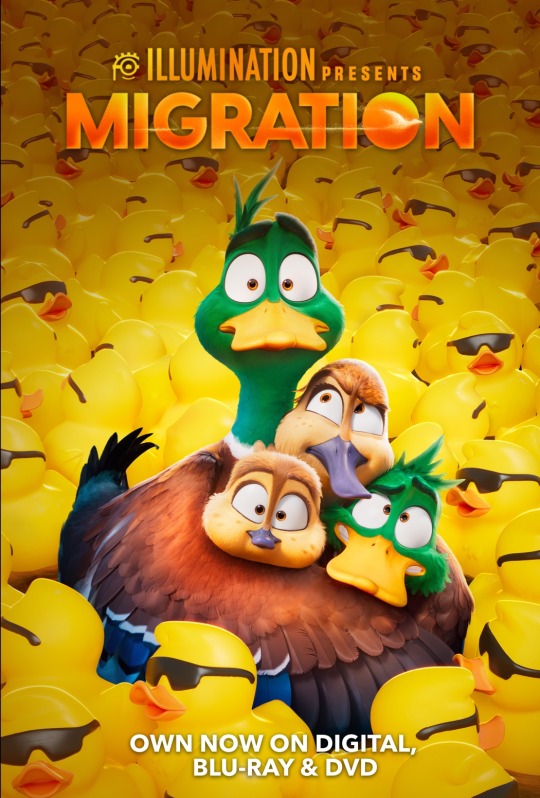
Before I start this review, I'll just have you know that the director who made this also made a movie called Ernest and Celestine. Pretty obscure film, but it was one of the very few films I actually gave a 9 out of 10. Now, granted, I was young back when I first watched it and I could think differently now, but I'm just saying.
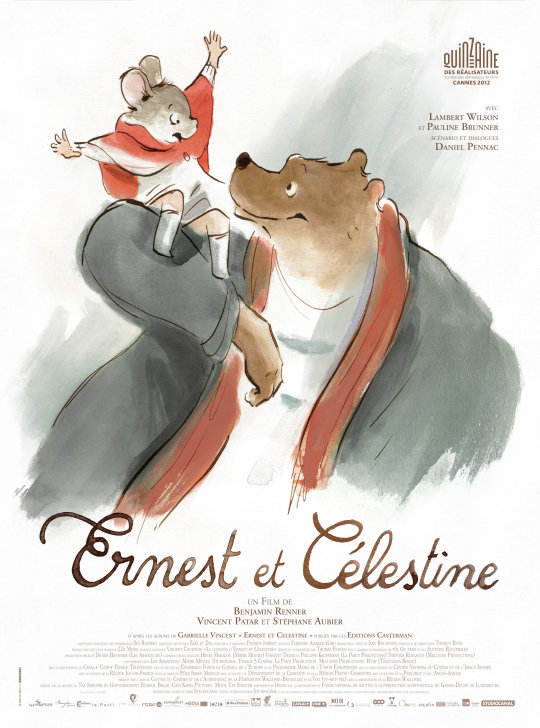
Which is why it's pretty amazing how Migration is actually quite the step down from Ernest and Celestine. It's still a decent movie, but it isn't anything to write home about.
Story
If you thought the Mario movie was simplistic, I'd say the Mario movie had a bit more going on than this one. On one hand, it's a basic adventure film and on the other hand, things happen that don't make sense. Like how the plot of the film gets started by Mack turning a 180 and deciding to migrate. The mallards get caught by these giant birds that they think want to eat them, but actually don't. During action moments, the birds would be screaming but nobody is alerted. And then the film loses its footing toward the end when they introduce a villain who wants to cook the birds. Nothing really special to say about the story. It's that weak.
Characters
The characters have their charmingly quirky moments, but like the story, they don't really feel meaningful. Mack is your average overprotective parent for some unexplained reason, the mother (forgot her name) is just a mother. Characters like the pigeon, parrot, and the uncle didn't really do much and probably shouldn't have been there in the first place. I do think the thin story hurts the characters somewhat. I do like Gwen, Dax, and the uncle personality-wise but I wish they were in a better story.
Overall
Clearly a movie made for children and I'm sure slice-of-life fans would like it, but it's no Despicable Me (another simple film by Illumination that would appeal to both adults and kids). Nothing much special, that's why this review is so short. It's cute, but it's not going to stick in my head after a while. I think it would've done better as a short or it could've used some more drafting in order to structure the story better.
I give Migration 6.1 bells out of 10.


Mooned

I always wanted to know what happened to Vector on the Moon, but idk, man. Like Migration, it just seemed like it was made to entertain the kids. Vector is not as cool as he once was in the film, and jog my memory, but I don't remember his suits having abilities besides flying? (And I just recently rewatched the first film). It's good for a laugh, but that's about it. Maybe it didn't really need to be made.
4.1 bells out of 10.

Both films have .1. Ain't that interesting?

10 notes
·
View notes
Text
All animal species (and a couple algae) that have kept the same scientific name since Linnaeus
The first work of taxonomy that is considered as having any scientific authority for animal species was the 10th edition of Linnaeus' Systema Naturae, published in 1758. (Also a book on spiders called Aranei Suecici, published one year before.) That's the foundational text of the binominal system of nomenclature of species still in use today. Since then most of Linnaeus' original species (4379 species, of which 185 mammals, 554 birds, 217 "amphibians" (including reptiles and cartilaginous fish), 379 fishes, 2104 "insects" (including various arthropods, of which 664 are beetles and 543 are moths & butterflies crammed into only 3 genera), and 940 "worms" (including basically all other invertebrates, and even some protists and algae)) have been dismembered, renamed, or at least moved to different genera (e.g. the house sparrow went from Fringilla domestica to Passer domesticus).
Here is a list of all of Linnaeus' original species from 1758 that still retain their original name. I believe they are 484 in total.
"Mammalia"
(Primates)
Homo sapiens (human)
Lemur catta (ring-tailed lemur)
Vespertilio murinus (rearmouse bat)
(Bruta)
Elephas maximus (Asian elephant)
Trichechus manatus (West Indian manatee)
Bradypus tridactylus (three-toed sloth)
Myrmecophaga tridactyla (giant anteater)
Manis pentadactylus (Chinese pangolin)
(Ferae)
Phoca vitulina (harbor seal)
Canis familiaris (dog)
Canis lupus (grey wolf)
Felis catus (house cat)
Viverra zibetha (Indian civet)
Mustela erminea (stoat)
Mustela furo (ferret)
Mustela lutreola (European mink)
Mustela putorius (wild ferret)
Ursus arctos (brown bear)
(Bestiae)
Sus scrofa (wild boar/pig)
Dasypus septemcinctus (seven-banded armadillo)
Dasypus novemcinctus (nine-banded armadillo)
Erinaceus europaeus (European hedgehog)
Talpa europaea (European mole)
Sorex araneus (common shrew)
Didelphis marsupialis (common opossum)
(Glires)
Rhinoceros unicornis (Indian rhinoceros)
Hystrix brachyura (Malayan porcupine)
Hystrix cristata (crested porcupine)
Lepus timidus (common hare)
Castor fiber (European beaver)
Mus musculus (house mouse)
Sciurus vulgaris (red squirrel)
(Pecora)
Camelus dromedarius (dromedary camel)
Camelus bactrianus (Asian camel)
Moschus moschiferus (musk deer)
Cervus elaphus (red deer)
Capra hircus (goat)
Capra ibex (Alpine ibex)
Ovis aries (sheep)
Bos taurus (cow)
Bos indicus (zebu)
(Belluae)
Equus caballus (horse)
Equus asinus (donkey)
Equus zebra (mountain zebra)
Hippopotamus amphibius (hippopotamus)
(Cete)
Monodon monoceros (narwhal)
Balaena mysticetus (bowhead whale)
Physeter macrocephalus (sperm whale)
Delphinus delphis (common dolphin)
"Aves"
(Accipitres)
Vultur gryphus (Andean condor)
Falco tinnunculus (common kenstrel)
Falco sparverius (sparrowhawk)
Falco columbarius (pigeonhawk)
Falco subbuteo (Eurasian hobby)
Falco rusticolus (gyrfalcon)
Strix aluco (tawny owl)
Lanius excubitor (great grey shrike)
Lanius collurio (red-backed shrike)
Lanius schach (long-tailed shrike)
(Picae)
Psittacus erithacus (grey parrot)
Ramphastos tucanus (white-throated toucan)
Buceros bicornis (great hornbill)
Buceros rhinoceros (rhinoceros hornbill)
Crotophaga ani (smooth-billed ani)
Corvus corax (raven)
Corvus corone (carrion crow)
Corvus frugilegus (rook)
Corvus cornix (hooded crow)
Coracias oriolus (golden oriole)
Coracias garrulus (European roller)
Gracula religiosa (hill myna)
Paradisaea apoda (greater bird-of-paradise)
Cuculus canorus (common cuckoo)
Jynx torquilla (wryneck)
Picus viridis (green woodpecker)
Sitta europaea (Eurasian nuthatch)
Merops apiaster (European bee-eater)
Merops viridis (blue-throated bee-eater)
Upupa epops (Eurasian hoopoe)
Certhia familiaris (Eurasian treecreeper)
Trochilus polytmus (red-billed streamertail hummingbird)
(Anseres)
Anas platyrhynchos (mallard duck)
Anas crecca (teal duck)
Mergus merganser (common merganser)
Mergus serrator (red-breasted merganser)
Alca torda (razorbill auk)
Procellaria aequinoctialis (white-chinned petrel)
Diomedea exulans (wandering albatross)
Pelecanus onocrotalus (great white pelican)
Phaeton aethereus (red-billed tropicbird)
Larus canus (common gull)
Larus marinus (great black-backed gull)
Larus fuscus (lesser black-backed gull)
Sterna hirundo (common tern)
Rhynchops niger (black skimmer)
(Grallae)
Phoenicopterus ruber (American flamingo)
Platalea leucorodia (Eurasian spoonbill)
Platalea ajaia (roseate spoonbill)
Mycteria americana (wood stork)
Ardea cinerea (grey heron)
Ardea herodias (blue heron)
Ardea alba (great egret)
Scolopax rusticola (Eurasian woodcock)
Charadrius hiaticula (ringed plover)
Charadrius alexandrinus (Kentish plover)
Charadrius vociferus (killdeer plover)
Charadrius morinellus (Eurasian dotterel)
Recurvirostra avosetta (pied avocet)
Haematopus ostralegus (Eurasian oystercatcher)
Fulica atra (Eurasian coot)
Rallus aquaticus (water rail)
Psophia crepitans (grey-winged trumpeter)
Otis tarda (great bustard)
Struthio camelus (ostrich)
(Gallinae)
Pavo cristatus (Indian peafowl)
Meleagris gallopavo (wild turkey)
Crax rubra (great curassow)
Phasianus colchicus (common pheasant)
Tetrao urogallus (western capercaillie)
(Passeres)
Columba oenas (stock dove)
Columba palumbus (wood pigeon)
Alauda arvensis (Eurasian skylark)
Sturnus vulgaris (European starling)
Turdus viscivorus (mistle thrush)
Turdus pilaris (fieldfare thrush)
Turdus iliacus (redwing thrush)
Turdus plumbeus (red-legged thrush)
Turdus torquatus (ring ouzel)
Turdus merula (blackbird)
Loxia curvirostra (crossbill)
Emberiza hortulana (ortolan bunting)
Emberiza citrinella (yellowhammer)
Emberiza calandra (corn bunting)
Fringilla coelebs (common chaffinch)
Motacilla alba (white wagtail)
Motacilla lava (yellow wagtail)
Parus major (great tit)
Hirundo rustica (barn swallow)
Caprimulgus europaeus (European nightjar)
"Amphibia"
(Reptiles)
Testudo graeca (Greek tortoise)
Draco volans (flying dragon)
Lacerta agilis (sand lizard)
Rana temporaria (common frog)
(Serpentes)
Crotalus horridus (timber rattlesnake)
Crotalus durissus (tropical rattlesnake)
Boa constrictor (common boa)
Coluber constrictor (eastern racer)
Anguis fragilis (slowworm)
Amphisbaena alba (red worm lizard)
Caecilia tentaculata (white-bellied caecilian)
(Nantes)
Petromyzon marinus (sea lamprey)
Raja clavata (thornback ray)
Raja miraletus (brown ray)
Squalus acanthias (spiny dogfish)
Chimaera monstrosa (rabbitfish)
Lophius piscatorius (anglerfish)
Acipenser sturio (sea sturgeon)
Acipenser ruthenus (sterlet sturgeon)
"Pisces"
(Apodes)
Muraena helena (Mediterranean moray)
Gymnotus carapo (banded knifefish)
Trichiurus lepturus (cutlassfish)
Anarhichas lupus (Atlantic wolffish)
Ammodytes tobianus (lesser sandeel)
Xiphias gladius (swordfish)
Stromateus fiatola (blue butterfish)
(Jugulares)
Callionymus lyra (common dragonet)
Uranoscopus scaber (stargazer)
Trachinus draco (greater weever)
Gadus morhua (Atlantic cod)
Blennius ocellaris (butterfly blenny)
Ophidion barbatum (snake cusk-eel)
(Thoracici)
Cyclopterus lumpus (lumpsucker)
Echeneis naucrates (sharksucker)
Coryphaena equiselis (pompano)
Coryphaena hippurus (dorado)
Gobius niger (black goby)
Govius paganellus (rock goby)
Cottus gobio (European bullhead)
Scorpaena porcus (black scorpionfish)
Scorpaena scrofa (red scorpionfish)
Zeus faber (John Dory)
Pleuronectes platessa (European plaice)
Chaetodon striatus (banded butterflyfish)
Chaetodon capistratus (foureye butterflyfish)
Sparus aurata (gilt-head bream)
Labrus merula (brown wrasse)
Labrus mixtus (cuckoo wrasse)
Labrus viridis (green wrasse)
Sciaena umbra (brown meagre)
Perca fluviatilis (European perch)
Gasterosteus aculeatus (three-spined stickleback)
Scomber scombrus (Atlanti mackerel)
Mullus barbatus (red mullet)
Mullus surmuletus (surmullet)
Trigla lyra (piper gurnard)
(Abdominales)
Cobitis taenia (spined loach)
Silurus asotus (Amur catfish)
Silurus glanis (Wels catfish)
Loricaria cataphracta (suckermouth catfish)
Salmo carpio (Garda trout)
Salmo trutta (brown trout)
Salmo salar (Atlantic salmon)
Fistularia tabacaria (bluespotted cornetfish)
Esox lucius (northern pike)
Argentina sphyraena (European argentine)
Atherina hepsetus (Mediterranean sand smelt)
Mugil cephalus (flathead mullet)
Exocoetus volitans (tropical flying fish)
Polynemus paradiseus (Paradise threadfin)
Clupea harengus (Atlantic herring)
Cyprinus carpio (common carp)
(Branchiostegi)
Mormyrus caschive (bottlenose elephantfish)
Balistes vetula (queen triggerfish)
Ostracion cornutus (longhorn cowfish)
Ostracion cubicus (yellow boxfish)
Tetraodon lineatus (Fahaka pufferfish)
Diodon hystrix (spot-fin porcupinefish)
Diodon holocanthus (long-spine porcupinefish)
Centriscus scutatus (grooved shrimpfish)
Syngnathus acus (common pipefish)
Syngnathus pelagicus (pelagic pipefish)
Syngnathus typhle (broad-nosed pipefish)
Pegasus volitans (longtail seamoth)
"Insecta"
(Coleoptera)
Scarabaeus sacer (sacred scarab)
Dermestes lardarius (larder beetle)
Dermestes murinus (larder beetle)
Hister unicolor (clown beetle)
Hister quadrimaculatus (clown beetle)
Silpha obscura (carrion beetle)
Cassida viridis (tortoise beetle)
Cassida nebulosa (tortoise beetle)
Cassida nobilis (tortoise beetle)
Coccinella trifasciata (ladybug)
Coccinella hieroglyphica (ladybug)
[Coccinella 5-punctata, 7-punctata, 11-punctata, and 24-punctata survive as quinquepunctata, septempunctata, undecimpunctata, and vigintiquatorpunctata]
Chrysomela populi (leaf beetle)
Chrysomela lapponica (leaf beetle)
Chrysomela collaris (leaf beetle)
Chrysomela erythrocephala (leaf beetle)
Curculio nucum (nut weevil)
Attelabus surinamensis (leaf-rolling weevil)
Cerambyx cerdo (capricorn beetle)
Leptura quadrifasciata (longhorn beetle)
Cantharis fusca (soldier beetle)
Cantharis livida (soldier beetle)
Cantharis oscura (soldier beetle)
Cantharis rufa (soldier beetle)
Cantharis lateralis (soldier beetle)
Elater ferrugineus (rusty click beetle)
Cicindela campestris (green tiger beetle)
Cicindela sylvatica (wood tiger beetle)
Buprestis rustica (jewel beetle)
[Buprestis 8-guttata survives as octoguttata]
Dytiscus latissimus (diving beetle)
Carabus coriaceus (ground beetle)
Carabus granulatus (ground beetle)
Carabus nitens (ground beetle)
Carabus hortensis (ground beetle)
Carabus violaceus (ground beetle)
Tenebrio molitor (mealworm)
Meloe algiricus (blister beetle)
Meloe proscarabaeus (blister beetle)
Meloe spec (blister beetle)
Mordela aculeata (tumbling glower beetle)
Necydalis major (longhorn beetle)
Staphylinus erythropterus (rove beetle)
Forficula auricularia (common earwig)
Blatta orientalis (Oriental cockroach)
Gryllus campestris (field cricket)
(Hemiptera)
Cicada orni (cicada)
Notonecta glauca (backswimmer)
Nepa cinerea (water scorpion)
Cimex lectularius (bedbug)
Aphis rumici (black aphid)
Aphis craccae (vetch aphid)
Coccus hesperidum (brown scale insect)
Thrips physapus (thrips)
Thrips minutissimum (thrips)
Thrips juniperinus (thrips)
(Lepidoptera)
Papilio paris (Paris peacock butterfly)
Papilio helenus (red Helen butterfly)
Papilio troilus (spicebush swallowtail butterfly)
Papilio deiphobus (Deiphobus swallowtail butterfly)
Papilio polytes (common Mormon butterfly)
Papilio glaucus (eastern tiger swallowtail butterfly)
Papilio memnon (great Mormon butterfly)
Papilio ulysses (Ulysses butterfly)
Papilio machaon (Old World swallowtail butterfly)
Papilio demoleus (lime swallowtail butterfly)
Papilio nireus (blue-banded swallowtail butterfly)
Papilio clytia (common mime butterfly)
Sphinx ligustri (privet hawk-moth)
Sphinx pinastri (pine hawk-moth)
[genus Phalaena was suppressed, but seven subgenera created by Linnaeus are now valid as genera]
(Neuroptera)
Libellula depressa (chaser dragonfly)
Libellula quadrimaculata (four-spotted skimmer dragonfly)
Ephemera vulgata (mayfly)
Phryganea grandis (caddisfly)
Hemerobius humulinus (lacewing)
Panorpa communis (scorpionfly)
Panorpa germanica (scorpionfly)
Raphidia ophiopsis (snakefly)
(Hymenoptera)
Cynips quercusfolii (oak gall wasp)
Tenthredo atra (sawfly)
Tenthredo campestris (sawfly)
Tenthredo livida (sawfly)
Tenthredo mesomela (sawfly)
Tenthredo scrophulariae (sawfly)
Ichneumon extensorius (parasitoid wasp)
Ichneumon sarcitorius (parasitoid wasp)
Sphex ichneumoneus (digger wasp)
Vespa crabro (European hornet)
Apis mellifera (honey bee)
Formica fusca (silky ant)
Mutilla europaea (large velvet ant)
(Diptera)
Oestrus ovis (sheep botfly)
Tipula oleracea (marsh cranefly)
Tipula hortorum (cranefly)
Tipula lunata (cranefly)
Musca domestica (housefly)
Tabanus bovinus (pale horsefly)
Tabanus calens (horsefly)
Tabanus bromius (brown horsefly)
Tabanus occidentalis (horsefly)
Tabanus antarcticus (horsefly)
Culex pipiens (house mosquito)
Empis borealis (dance fly)
Empis pennipes (dance fly)
Empis livida (dance fly)
Conops flavipes (thick-headed fly)
Asilus barbarus (robberfly)
Asilus crabroniformis (hornet robberfly)
Bombylius major (bee fly)
Bombylius medius (bee fly)
Bombylius minor (bee fly)
Hippobosca equina (forest fly)
(Aptera)
Lepisma saccharina (silverfish)
Podura aquatica (water springtail)
Termes fatale (termite)
Pediculus humanus (human louse)
Pulex irritans (human flea)
Acarus siro (flour mite)
Phalangium opilio (harvestman)
Araneus angulatus (orb-weaving spider)
Araneus diadematus (European garden spider)
Araneus marmoreus (marbled orbweaver)
Araneus quadratus (four-spotted orbweaver -- last four are by Clerck 1757, some of the very few surviving pre-Linnean names!)
Scorpio maurus (large-clawed scorpion)
Cancer pagurus (brown crab)
Oniscus asellus (common woodlouse)
Scolopendra gigantea (giant centipede)
Scolopendra morsitans (red-headed centipede)
Julus fuscus (millipede)
Julus terrestris (millipede)
"Vermes"
(Intestina)
Gordius aquaticus (horsehair worm)
Lumbricus terrestris (common earthworm)
Ascaris lumbricoides (giant roundworm)
Fasciola hepatica (liver fluke)
Hirudo medicinalis (medicinal leech)
Myxine glutinosa (Atlantic hagfish)
Teredo navalis (shipworm)
[shout out to Furia infernalis, a terrifying carnivorous jumping worm that Linnaeus described, but which doesn't seem to actually exist]
(Mollusca)
Limax maximus (leopard slug)
Doris verrucosa (warty nudibranch)
Nereis caerulea (ragworm)
Nereis pelagica (ragworm)
Aphrodita aculeata (sea mouse)
Lernaea cyprinacea (anchor worm)
Scyllaea pelagica (Sargassum nudibranch)
Sepia officinalis (common cuttlefish)
Asterias rubens (common starfish)
Echinus esculentus (edible sea urchin)
(Testacea)
Chiton tuberculatus (West Indian green chiton)
Lepas anatifera (goose barnacle)
Pholas dactylus (common piddock)
Mya arenaria (softshell clam)
Mya truncata (truncate softshell)
Solen vagina (razor clam)
Tellina laevigata (smooth tellin)
Tellina linguafelis (cat-tongue tellin)
Tellina radiata (sunrise tellin)
Tellina scobinata (tellin)
Cardium costatum (ribbed cockle)
Donax cuneatus (wedge clam)
Donas denticulatus (wedge clam)
Donax trunculus (wedge clam)
Venus casina (Venus clam)
Venus verrucosa (warty venus)
Spondylus gaederopus (thorny oyster)
Spondylus regius (thorny oyster)
Chama lazarus (jewel box shell)
Chama gryphoides (jewel box shell)
Arca noae (Noah's ark shell)
Ostrea edulis (edible oyster)
Anomia aurita (saddle oyster)
Anomia ephippium (saddle oyster)
Anomia hysterita (saddle oyster)
Anomia lacunosa (saddle oyster)
Anomia spec (saddle oyster)
Anomia striatula (saddle oyster)
Mytilus edulis (blue mussel)
Pinna muricata (pen shell)
Pinna nobilis (fan mussel)
Pinna rudis (rough pen shell)
Argonauta argo (argonaut)
Nautilus pompilius (chambered nautilus)
Conus ammiralis (admiral cone snail)
Conus aulicus (princely cone snail)
Conus aurisiacus (cone snail)
Conus betulinus (betuline cone snail)
Conus bullatus (bubble cone snail)
Conus capitaneus (captain cone snail)
Conus cedonulli (cone snail)
Conus ebraeus (black-and-white cone snail)
Conus figulinus (fig cone snail)
Conus genuanus (garter cone snail)
Conus geographus (geographer cone snail)
Conus glaucus (glaucous cone snail)
Conus granulatus (cone snail)
Conus imperialis (imperial cone snail)
Conus litteratus (lettered cone snail)
Conus magus (magical cone snail)
Conus marmoreus (marbled cone snail)
Conus mercator (trader cone snail)
Conus miles (soldier cone snail)
Conus monachus (monastic cone snail)
Conus nobilis (noble cone snail)
Conus nussatella (cone snail)
Conus princeps (prince cone snail)
Conus spectrum (spectrecone snail)
Conus stercusmuscarum (fly-specked cone snail)
Conus striatus (striated cone snail)
Conus textile (cloth-of-gold cone snail)
Conus tulipa (tulip cone snail)
Conus varius (freckled cone snail)
Conus virgo (cone snail)
Cypraea tigris (tiger cowry shell)
Bulla ampulla (Pacific bubble shell)
Voluta ebraea (Hebrew volute)
Voluta musica (music volute)
Buccinum undatum (common whelk)
Strombus pugilis (fighting conch)
Murex tribulus (caltrop murex)
Trochus maculatus (maculated top shell)
Turbo acutangulus (turban shell)
Turbo argyrostomus (silver-mouth turban shell)
Turbo chrystostomus (gold-mouth turban shell)
Turbo marmoratus (green turban shell)
Turbo petholatus (turban shell)
Turbo sarmaticus (giant turban shell)
Helix lucorum (Mediterranean snail)
Helix pomatia (Roman snail)
Nerita albicilla (blotched nerite)
Nerita chamaeleon (nerite)
Nerita exuvia (snakeskin nerite)
Nerita grossa (nerite)
Nerita histrio (nerite)
Nerita peloronta (bleeding tooth)
Nerita plicata (nerite)
Nerita polita (nerite)
Nerita undata (nerite)
Haliotis asinina (ass-ear abalone)
Haliotis marmorata (marbled abalone)
Haliotis midae (South African abalone)
Haliotis parva (canaliculate abalone)
Haliotis tuberculata (green ormer)
Haliotis varia (common abalone)
Patella caerulea (Mediterranean limpet)
Patella pellucida (blue-rayed limpet)
Patella vulgata (European limpet)
Dentalium elephantinum (elephant tusk)
Dentalium entale (tusk shell)
[genus Serpula is still in use with none of its original species]
(Lithophyta)
Tubipora musica (organ pipe coral)
Millepora alcicornis (sea ginger fire coral)
Madrepora oculata (zigzag stone coral)
(Zoophyta)
Isis hippuris (sea bamboo)
Isis ochracea (sea bamboo)
Gorgonia flabellum (Venus fan)
Gorgonia ventalina (purple sea fan)
Alcyonium bursa (soft coral)
Alcyonium digitatum (dead man's fingers)
Tubularia indivisa (oaten ipes hydroid)
Corallina officinalis (coralline red alga)
Sertularia argentea (sea fern)
Sertularia cupressoides (hydroid)
Pennatula phosphorea (sea pen)
Taenia solium (pork tapeworm)
Volvox globator (colonial alga)
[genus Hydra is still in use with none of its original species]
15 notes
·
View notes
Text


The Whitman Family
Aphrodite: Cosmetics Conglomerate
The Whitman family is founded from humble beginnings that burgeoned into a multinational empire, weaving a saga of ambition, beauty, and the enduring legacy of Whitman Cosmetics. The company's roots trace back to a small perfume shop run by first generation immigrants, eventually evolving into a Midtown Manhattan-based powerhouse resulting in Whitman Cosmetics being known as a a multinational cosmetics company, manufacturer and marketer of makeup, skincare, perfume, and hair care products. First Whitman (76) serves as the CEO of the company, unable to step down as she hasn’t found a “suitable replacement” yet - much to the chagrin of her husband, First Stirling (75), who stepped down as the CFO for Whitman Cosmetics two years ago and just wants to retire in peace.
Their eldest child, First Hawthorne (48) has ventured into the family business as a fragrance chemist for the company, focusing on aromachology and how fragrances can impact mood or feelings. She and her husband First Hawthorne (49) have started their own small family with two children. After their father retired, the role of CFO was handed down to the eldest son, First Whitman (46) who was an extremely able and capable candidate for the role, though many in the company took it as a bit of a slight since he had not worked for Whitman Cosmetics as long as other candidates in the running. Regardless, alongside his wife First Whitman (46) and four daughters, he has managed to perform well in the role while contending with the pressure to find a successor CEO when his mother retires.
The remaining siblings have all ventured around Whitman Cosmetics in one way or another: First Whitman (42) is a professional model and has long been the face of Whitman Cosmetics, but finds himself grappling with the inevitable challenge of aging in an industry fixated on youth. Meanwhile, First Whitman (37) is the Chief Marketing Officer for the company and is trying to usher in a new generation of marketing strategies by collaborating with his younger brother First Whitman (35), a social media influencer and socialite that is always attending the classiest of affairs in New York City.
To aid in gaining the attention of younger generations are the twin daughters, First Whitman (33) and First Whitman (33). Using their family name and their own unique skills in the cosmetic industry, they have leveraged their family name and resources to establish a private boutique in Manhattan where they work as a makeup artist and hairstylist respectively, providing high end clientele with everything they might need in order to look their best. They have recently started to collaborate with First Cheng (39), hoping to combine her talents as a fashion designer to create an entire creative fashion Haus in the heart of New York City and take their family reputations and wealth to new heights.
First Whitman: 76 Years Old, CEO of Whitman Cosmetics, Catherine O'Hara, Available
+ First Stirling: 75 Years Old, Retired Chief Financial Officer of Whitman Cosmetics, Willem Dafoe, Available
First Hawthorne: 48 Years Old, Fragrance Chemist, Chrissy Metz, Available
+ First Hawthorne: 49 Years Old, Open Occupation, Michael Shannon, Available
----- First Hawthorne: 23 Years Old, Open Occupation, Felix Mallard, Available
----- First Hawthorne: 21 Years Old, Open Occupation, Joe Locke, Available
First Whitman: 46 Years Old, Chief Financial Officer of Whitman Cosmetics, Henry Cavill, Available
+ First Whitman: 46 Years Old, Open Occupation, Kristen Bell, Available
----- First Whitman: 25 Years Old, Open Occupation, Natalia Dyer, Available
----- First Whitman: 23 Years Old, Open Occupation, Phoebe Deynover, Available
----- First Whitman: 21 Years Old, Open Occupation, Renee Rapp 1, Available *
----- First Whitman: 21 Years Old, Open Occupation, Renee Rapp 2, Available *
* Note: Whitman (21) and Whitman (21) are identical twins
First Whitman: 42 Years Old, Model, Sam Claflin, Available
First Whitman: 37 Years Old, Chief Marketing Officer of Whitman Cosmetics, Robert Pattinson, Available
First Whitman: 35 Years Old, Socialite and Social Media Influencer, Jonathan Bailey, Available
First Whitman: 33 Years Old, Make Up Artist, Margot Robbie, Available *
* Note: Whitman (33) and Whitman (33) are fraternal twins
First Whitman: 33 Years Old, Hairstylist, Samara Weaving, Available *
* Note: Whitman (33) and Whitman (33) are fraternal twins
7 notes
·
View notes